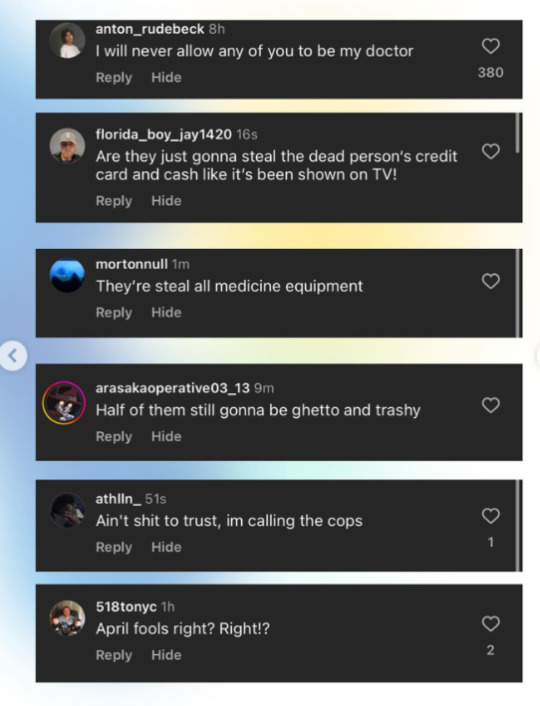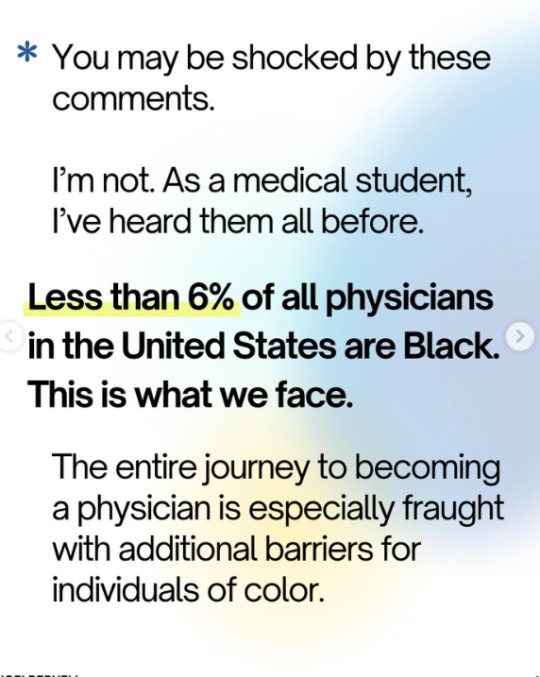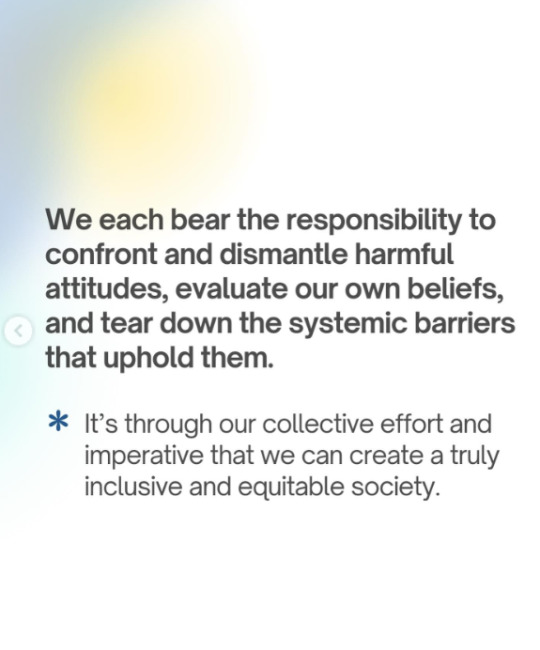Text
Unity in Care: Embracing Multiculturalism in Medical Practice
When someone mentions the word “doctor”, we typically think of someone who is white, male, authoritative, and guiding others to success. We don’t think of those of different races, cultures, genders, etc., because we aren’t exposed to those with diversified backgrounds in the healthcare industry as they don’t fit into the narrative. It is very clear that there is a lack of representation, especially those of different races, in the medical field.
According to ABC, a study conducted in 2018 by the Association of American Medical Colleges found that only 5% of physicians in the United States are Black or African American, compared to the 56.2% of United States physicians who are white. Though this statistic is shocking, it is not surprising. We cannot have a multitude of doctors who aren’t primarily white if we aren’t giving those of different descent an equal opportunity and a fair chance. There are fewer black students in medical school, while the number of white students is dominating, much like what can be seen in the medical field. Those of different cultures are not offered similar opportunities, much of which has to do with systemic racism and preconceived stereotypes. We can clearly see that white individuals have more opportunities and exposure to the medical field, and even when those of different races put in the same amount of work, if not more, to become a doctor, it is unacceptable to white people because they deem those who are, in this case, black, to be unqualified.
This type of discrimination in the healthcare field is said to be due to a lack of consideration given to an individual or group because of unjustified opinions. The two main types of discriminatory acts or commons are microaggressions and macroaggressions; macroaggressions are more overt and radical forms of racism rooted in a system, whereas microaggressions may cause damage to the oppressor’s mental health, which can cause lower self-esteem, and poorer self-care, an increase of substance abuse with heightening depression, suicidal ideation, and anxiety. (Togioka para.4). In a world where we aren’t giving those of different races and backgrounds a chance, how are we supposed to offer examples of diversity for others? When people of color do not see themselves represented in the medical field, this leads to discouragement and an imbalance in the type of care this group of people is receiving. When we don’t have doctors that can cater to different cultures and when these people in need can’t be understood, it is a disservice to all and leads to miscommunications, leaving the possibility that a life that could’ve been saved is now lost, “Perhaps the most critical value of diversity in health care is improving patient outcomes. Current disparities in access and outcomes, based on various barriers to inclusion, are myriad. Language and/or cultural barriers deter some patients of diverse backgrounds from seeking preventative or early care thus compromising long-term outcomes. In order to provide true patient-centered care, health care workers should look or pray or speak of love like the patients they serve.” (Rosenkranz 1058-1059).
youtube
To increase the inclusivity of healthcare and medical help, there needs to be a clear level of understanding between the patient and the doctor. If there is a person who speaks Spanish, and the doctor does not speak Spanish and can’t translate properly, there is a life at stake when there never needed to be in the first place. Had we made sure to hire leadership that advocated for the inclusion of those of different races, we wouldn’t have to worry as much about these instances, and everyone could be proactive. We are beginning to struggle to find doctors who genuinely follow their promises and guidelines to help everyone, despite their differences. Due to this rising problem, we see a lack of care for those in minority groups, as they are unable to get sufficient help that is crucial to their health.
The Covid-19 pandemic brought health disparities that were already happening to the forefront and have only been amplified due to the increase of incidence and mortality rates of COVID-19 patients. This led to certain racial and ethnic groups being affected at population levels due to biological and social factors that influence healthcare access, such as discrepancies in unemployment, income level, insurance, education, and cultural or language control and prevention. (Sarfraz para. 10). We are continuously being met with limitations for those of different ethnic groups, especially because they are consistently denied the help they need to receive to remain in good health. This problem is continuously growing, and we continue to see these numbers on the rise, “Conservative estimates indicate that more than 25 million individuals reside in areas with a shortage of health professionals and have limited access to quality healthcare.” (Mitchell 31). Without proper help and the right professionals taking charge and stepping into communities that are less fortunate to receive help, these communities and their well-being will only begin to worsen. We are stuck in an unwinnable situation because we need an increase of doctors from diverse backgrounds, but society is unaccepting of these doctors.
youtube
We can see the reaction to these problems highlighted throughout the media. An Instagram user, Joel Bervell, posted a video to his account from the Student National Medical Association’s Annual Medical Education Conference of himself and other doctors of color, captioning the video “Meet the future doctors of America.” The comments on the post were incredibly racist, and it immediately took away the happiness from each of these new doctors, as well as the credibility they were just given. Though alarming, these comments were not shocking as this is something we are facing daily, where medical students who are Black face discrimination and are continuously having their abilities doubted. This man mentions in his post that he has been singled out and ostracized by professors, and there have been several microaggressions he has had to face. Rather than celebrating this academic achievement and being relieved to have an increase in the number of those willing to take care of us medically, people still have biases that shape our social and educational environments. People are still stuck in their ways, and although some people are urging to increase diversity in any workplace, it can never fully be successful if we aren’t all on the same page, and if we can’t all continue to survive equally.





Another media portrayal of this issue can be seen in the Netflix original All American. In season 2, episode 11, the main character Spencer James is shot by a gang member. He is rushed to the hospital, and when he is in surgery, his levels drop and the nurse doctor helping him, nurse Joy, says he needs something to get the most sufficient help possible. The doctor she is working with tells her that they are waiting to find out “what he is on”, implying that he is on drugs because he is black, and happened to be shot. Nurse Joy is taken aback, and fights to get Spencer the help he needs despite the color of his skin, or how the shooting came to be. She knew that as a doctor, it was her duty to do everything in her power to make sure he made it out alive and still healthy. When he finally woke up after surgery, the nurses told the doctors that Spencer James was one of the best football players they knew, and nurse Joy gave the rest of the team she was working with an I told you so look. She hadn’t known anything about him prior, but she still fought to make sure he was getting the treatment he needed. Although this is just a TV show, it is an accurate representation of what people of color have to go through, and it shows that if there are no nurses or doctors who advocate for what is right and what’s wrong, we are unjust and leading precious lives to failure.
youtube
The moral of the story is that it is crucial for us to establish a more diversified medical field, and it is our duty to help those who may be less fortunate to receive the help every human should be obligated to get. With increased awareness and review of standards, I hope we are able to advocate for those with unheard voices and continue to hire those from different backgrounds and viewpoints.
Works Cited
Howard, Jacqueline. “Only 5.7% of US Doctors Are Black, and Experts Warn the Shortage Harms Public Health.” CNN, 21 Feb. 2023, www.cnn.com/2023/02/21/health/black-doctors-shortage-us/index.html.
Mitchell, Dennis. A Need for Diversity in the Oral Health Workforce. May 2015.
News, A. B. C. “Black Health Care Workers Shine Spotlight on Issues of Diversity in Medical Field.” ABC News, abcnews.go.com/GMA/Wellness/black-health-care-workers-shine-spotlight-issues-diversity/story?id=76104296.
Rosenkranz, Kari M., et al. “Diversity, Equity and Inclusion in Medicine: Why It Matters and How Do We Achieve It?” Journal of Surgical Education, vol. 78, no. 4, Dec. 2020, www.sciencedirect.com/science/article/pii/S1931720420304463, https://doi.org/10.1016/j.jsurg.2020.11.013.
Sarfraz A, Sarfraz Z, Barrios A, et al. Understanding and Promoting Racial Diversity in Healthcare Settings to Address Disparities in Pandemic Crisis Management. Journal of Primary Care & Community Health. 2021;12. doi:10.1177/21501327211018354
Togioka, Brandon M., et al. “Diversity and Discrimination in Healthcare.” PubMed, StatPearls Publishing, 14 Aug. 2023, www.ncbi.nlm.nih.gov/books/NBK568721/.
1 note
·
View note